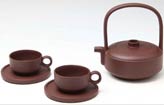X-Ray
Quiet manners, silken dreams
Updated: 2010-02-09 09:55
By Raymond Zhou (China Daily)
Tea, sweetened with talk and tamale

Jiangnan is as moist as Sichuan, but Jiangnan people have a sweet tooth. The amount of pepper a typical Sichuan family consumes a day can last a month in my hometown. We prefer green tea, especially Hangzhou's Dragon Well (longjing) or Suzhou's Green Snail Spring (biluochun), sipped at a moderate speed - until it turns so insipid you can no longer get the tea taste out of it.
The morning tea is a ritual for many farmers, exclusively males. Some trek an hour to the nearest town and have a tea-drinking session at one of numerous teahouses. Women, on the other hand, make a trip to the farmers' market.
My childhood bedroom was so close to a teahouse I could overhear much of the conversations from the tea drinkers. It was the kind of idle chat that did not yield an iota of substance or drama. Yet these people - usually the old - do it day in and day out, rain or shine.
Zongzi is a popular snack in Jiangnan. The Chinese tamale is found almost everywhere in Asia, but in the small towns in northern Zhejiang one does not wait till the Dragon Boat Festival. It is often an excuse for family gatherings, somewhat like making dumplings in Northern China. My grandma used to pick a bunch of broad bamboo leaves, prepare the glutinous rice, some pork and dates.
Wrapping a zongzi is tricky. Some can do it with one leaf. I needed as many as three. We always used straw to tie it up. Nowadays, it's done by using threads and more efficiently. While there are more varieties now, the taste is not as good as the homemade kind. But it is still good enough for tourists and many old brands have been revived.
Gusao cookie is another local specialty. It is a kind of cookie that's not baked but pressed in a mold. Legend has it that more than 200 years ago there was a bakery in Wuzhen, a mom-and-pop shop. To prevent their recipe from falling into the hands of a potential competitor, the owners let the daughter-in-law know it, but excluded their own daughter from sharing the secret. The daughter, in a fit of pique, put some salt into the ingredients that included flour, sugar, sesame and lard. But this made the cookie even more yummy. Hence, its name gusao, or sisters-in-law.
Baozi is a kind of bun you can eat with your hand. But Huzhou's Thousand-sheet Baozi is served in a bowl of noodle soup. It was invented in 1878 by a local snack vendor named Ding Lianfang. Now bearing his name, the baozi uses a thin tofu sheet to wrap the minced pork, bamboo shoots and shrimps. It comes in a bite size, or 5 cm to be exact. But it packs a delicious punch.
Raymond Zhou

Specials

Biden Visits China
US Vice-President Joe Biden visits China August 17-22.

Star journalist leaves legacy
Li Xing, China Daily's assistant editor-in-chief and veteran columnist, died of a cerebral hemorrhage on Aug 7 in Washington DC, US.

Hot pots
Tea-making treasures catch the fancy of connoisseurs as record prices brew up interest